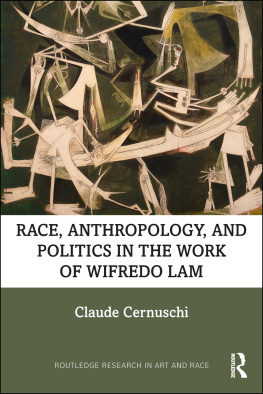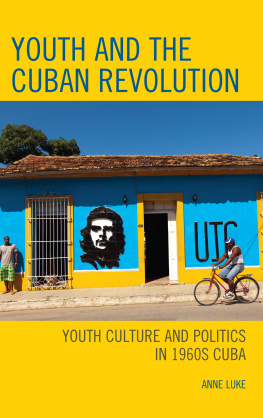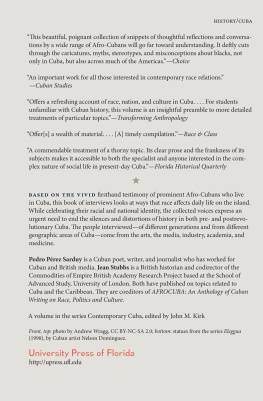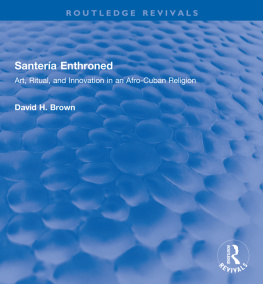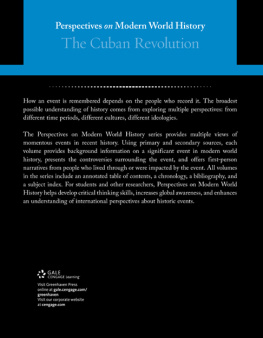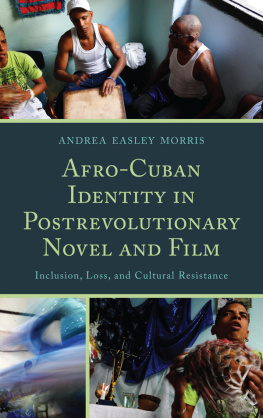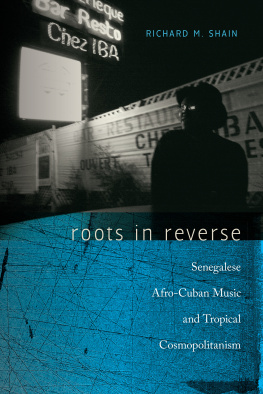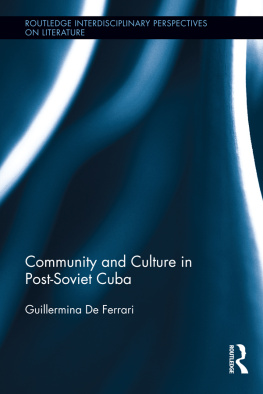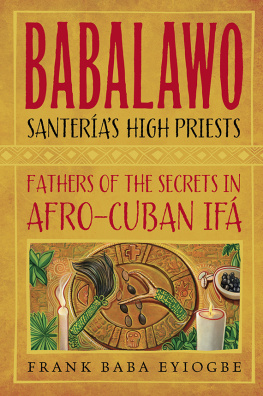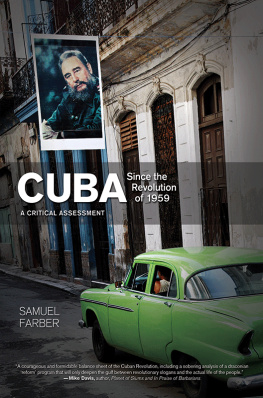Race, Anthropology, and Politics in the
Work of Wifredo Lam
This book reinterprets Wifredo Lams work with particular attention to its political implications, focusing on how these implications emerge from the artists critical engagement with 20th-century anthropology. Field work conducted in Cuba, including the witnessing of actual Afro-Cuban religious ritual ceremonies and information collected from informants, enhances the interpretive background against which we can construe the meanings of Lams art. In the process, Claude Cernuschi argues that Lam hoped to fashion a new hybrid style to foster pride and dignity in the Afro-Cuban community, as well as counteract the acute racism of Cuban culture.
Claude Cernuschi is Professor of Art History at Boston College, USA.
Cover image: Wifredo Lam, The Third World, 1966, oil on canvas, 251 300 cm Museo Nacional de Bellas Artes, Havana. 2018 Artists Rights Society (ARS), New York/ADAGP, Paris.
Routledge Research in Art and Race
Routledge Research in Art and Race is a new series focusing on race as examined by scholars working in the fields of art history and visual studies. Proposals for monographs and edited collections on this topic are welcomed.
For a full list of titles in this series, please visit https://www.routledge.com/art/series/RRAR
Henry Ossawa Tanner: Art, Faith, Race, and Legacy
Naurice Frank Woods, Jr.
The Black Arts Movement and the Black Panther Party in American Visual Culture
Jo-Ann Morgan
Race, Anthropology, and Politics in the Work of Wifredo Lam
Claude Cernuschi
Race, Anthropology, and Politics in the Work of Wifredo Lam
Claude Cernuschi

First published 2019
by Routledge
52 Vanderbilt Avenue, New York, NY 10017
and by Routledge
2 Park Square, Milton Park, Abingdon, Oxon, OX14 4RN
Routledge is an imprint of the Taylor & Francis Group, an informa business
2019 Taylor & Francis
The right of Claude Cernuschi to be identified as author of this work has been asserted by him/her in accordance with sections 77 and 78 of the Copyright, Designs and Patents Act 1988.
All rights reserved. No part of this book may be reprinted or reproduced or utilised in any form or by any electronic, mechanical, or other means, now known or hereafter invented, including photocopying and recording, or in any information storage or retrieval system, without permission in writing from the publishers.
Trademark notice : Product or corporate names may be trademarks or registered trademarks, and are used only for identification and explanation without intent to infringe.
Library of Congress Cataloging-in-Publication Data
Names: Cernuschi, Claude, 1961- author.
Title: Race, anthropology, and politics in the work of Wifredo Lam / Claude Cernuschi.
Description: New York: Routledge, 2019. | Series: Routledge research in art and race | Includes bibliographical references and index.
Identifiers: LCCN 2019004472 | ISBN 9780815393740 (hardback: alk. paper) |
ISBN 9781351187879 (ebook: alk. paper)
Subjects: LCSH: Lam, WifredoCriticism and interpretation. | Race in art.
Classification: LCC ND305.L3 C47 2019 | DDC 759.97291dc23
LC record available at https://lccn.loc.gov/2019004472
ISBN: 978-0-8153-9374-0 (hbk)
ISBN: 978-1-351-18787-9 (ebk)
Typeset in Sabon
by Deanta Global Publishing Services, Chennai, India
For Elizabeth Goizueta and Roberto Cobas Amate
Contents
Figures
Cover image: Wifredo Lam, The Third World , 1966, Oil on canvas
Color plates
I would like to express my sincere gratitude to the many individuals who have contributed to the conceptualization and completion of this project. At Routledge Press, I thank my editors, Isabella Vitti and Katie Armstrong, for their remarkable assistance with all aspects of this book; and Jayanthi Chander for her work on the copy-edited manuscript. For their help with photographic materials and reproduction rights, I particularly recognize Nurkia Daz, Joyce Faust, Val Nelson, Kate Shugert, Katja Weingartshofer, Jennifer Shaw, and Maria Fernanda Meza. Eva Kempinski requires special mention for her reminiscences of Claude Lvi-Strauss, and Beatriz Melian Pea for sharing so much of her collection with me.
I would also like to thank Ramn, Jorge, and Nercys Cernuda, Jason and Sonia Silverman, and Hortensia Soriano for their advice, kindness, and generosity. I would also like to recognize the assistance of other scholars working in the scholarly fields of art history or religious and cultural studies: Allison Morehead, Gemma Blackshaw, Janie Cohen, Carol Dixon, Roberto Goizueta, Harris Eisentadt, Julia Herzberg, Lowery Stokes Sims, Shannen Hill, Ivor Miller, Martin Tsang, and the three anonymous readers for Routledge Press, both for recommending publication and for their constructive suggestions for improving the manuscript. I have also greatly benefited from conversations with Diana Bramham, Henry Vidal Delgado, Lazara Menendez, Kyrah Daniels, Israel Moleiro Sarracino, and Jos Manuel Noceda. Eskil Lam and Dorota Dolega-Ritter have been extremely gracious, and generous with their time, answering countless questions, and giving me access to numerous materials in the Lam Archives in Paris.
I cannot find adequate words to thank Adeane Bregman, Bapst Librarian at Boston College. Ever since I joined the faculty there, she has helped me with an eagerness and enthusiasm I could scarcely match myself. I have always thought of her more as a dedicated research assistant than a librarian. My research is continuously in her debt. I have also greatly benefited from generosity of the Boston College Office of Sponsored Research and the Office of the Dean of Arts and Sciences at Boston College.
I also warmly acknowledge the continual moral support I have received from close friends: Marietta Cambareri, Roy Chatalbash, David Castriota, Stephen Kett, and from my colleagues in the Art, Art History, and Film Department at Boston College, who have made my academic tenure there so pleasant and enjoyable, and who have supported me in more ways than I can count. Although the entire department is hereby acknowledged, certain individuals merit special mention: Hartmut Austen, Karl Baden, Pamela Berger, Sheila Blair, Jonathan Bloom, Aurelia Campbell, Sammy Chong, Stoney Conley, Mark Cooper, Kenneth Craig, Sheila Gallagher, Khalid Khodi, Jeffery Howe, Charles Meyer, John Michalczyk, Michael Mulhern, Katherine Nahum, Nancy Netzer, and Andy Tavarelli. Our administrative assistant, Joanne Elliott, has also been a remarkable help, no matter what is thrown at her.
Of course, nothing would have been possible without the affection and encouragement of my mother, Ursula Cernuschi, and my wife, Suzy Forster, both of whom have sustained me with emotional support and affection throughout this project and much else. Lastly, I mention Elizabeth Goizueta and Roberto Cobas Amate. It was Elizabeth who first recruited me to contribute an essay on the work of Wifredo Lam for an exhibition at Boston College and who set me on this remarkable intellectual adventure. Roberto (along with his family, Xiomara and Robertico) opened their house to me in Havana, so much so that my wife and I consider all of them to be members of our family. It is impossible to express how much Elizabeth and Robertos help and friendship have meant to me; and so, with extreme gratitude, I warmly dedicate this book to both of them.

